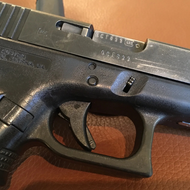Noticing Signs Of Wear And Tear On Your Firearms
May 1st 2025
Firearms are reliable tools designed to last for years when properly maintained. However, like any mechanical device, they’re subject to wear and tear over time. Recognizing the signs of wear early can ensure your firearm remains safe, reliable, and functional. Here are the key signs of wear and tear every gun owner should watch for:
1. Barrel Wear
The barrel’s condition is critical to your firearm’s accuracy and performance. Over time, repeated firing causes erosion in the rifling grooves or throat area of the barrel. Look for signs such as:
Reduced accuracy during shooting.
Visible pitting, rust, or scratches inside the barrel.
Erosion near the chamber or muzzle.
Regular cleaning and inspection can help mitigate these issues and extend the barrel's life.
2. Spring Fatigue
Springs in firearms, such as recoil springs or magazine springs, are under constant tension and compression. Over time, they can lose elasticity, leading to:
Failure to feed or eject rounds properly.
Weak or inconsistent cycling of the action.
Difficulty loading or retaining cartridges in magazines.
Replacing springs at regular intervals, as recommended by the manufacturer, is essential for reliable operation.
3. Extractor and Ejector Wear
The extractor and ejector are crucial for smooth cycling and proper ejection of spent casings. Signs of wear include:
Failure to extract or eject spent casings.
Damaged or chipped extractor hooks.
Uneven or weak ejection patterns.
Routine inspection and replacement when necessary can prevent jams and malfunctions.
4. Slide and Frame Wear
For semi-automatic pistols and rifles, the slide or bolt repeatedly contacts the frame during operation. Over time, this can cause:
Visible wear marks or grooves along contact surfaces.
Looseness or rattling between the slide and frame.
Increased recoil or misalignment of components.
Using proper lubrication can reduce friction and extend the life of these parts.
5. Firing Pin and Hammer Damage
Frequent dry firing or extended use can lead to firing pin or hammer wear, which may result in:
Light primer strikes or misfires.
Visible bending, chipping, or pitting on the firing pin.
Worn or rounded edges on the hammer.
Inspect these parts regularly and replace them if you notice significant wear.
6. Surface Finish Wear
The exterior finish of your firearm isn’t just for aesthetics—it also protects against corrosion. Signs of surface wear include:
Scratches, dings, or abrasions on the finish.
Rust spots or discoloration.
Loss of protective coating on high-friction areas.
Storing firearms in a dry, climate-controlled environment and applying protective oil can help prevent corrosion and surface damage.
7. Loose or Damaged Screws and Pins
Repeated firing generates vibration and shock that can loosen screws and pins. Symptoms include:
Wobbling or shifting components.
Difficulty maintaining proper alignment.
Missing screws or pins.
Check and tighten screws and pins regularly but avoid overtightening, which can strip threads or damage parts.
8. Trigger Wear
The trigger mechanism is a critical part of your firearm’s operation. Over time, components within the trigger assembly can wear, leading to:
Increased or inconsistent trigger pull weight.
Failure of the trigger to reset.
Excessive slack or creep in the trigger pull.
Routine cleaning and occasional inspection by a qualified gunsmith can prevent major trigger issues.
9. Magazine Wear
Magazines often take a beating during use and can exhibit signs of wear, including:
Bent or deformed feed lips.
Cracked or weakened magazine bodies.
Springs that fail to push rounds consistently.
Replace worn magazines to avoid reliability issues during shooting.
Maintaining Your Firearm
To minimize wear and tear:
Clean regularly: Remove residue, dirt, and fouling after each use.
Lubricate appropriately: Prevent metal-on-metal friction with proper gun oil or grease.
Inspect often: Check for visible damage or malfunction signs during routine maintenance.
Replace parts proactively: Don’t wait for a failure; replace components based on usage and manufacturer recommendations.
By staying vigilant and addressing signs of wear early, you can ensure your firearm remains reliable and safe for years to come.

